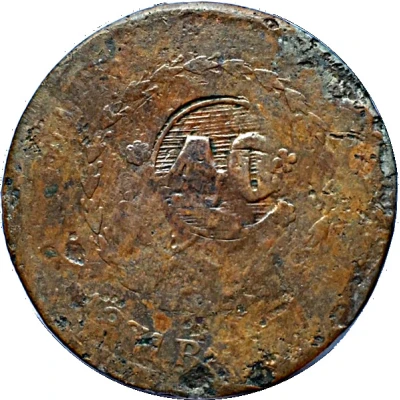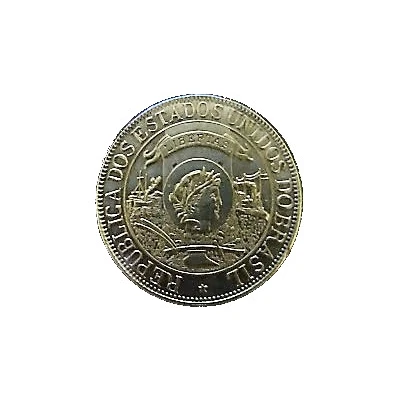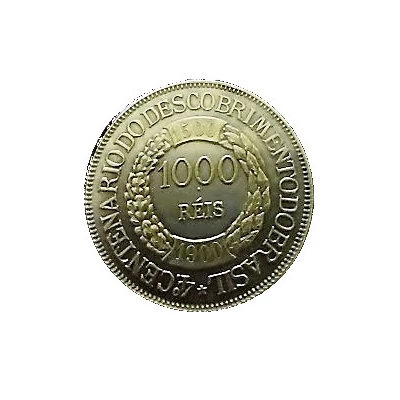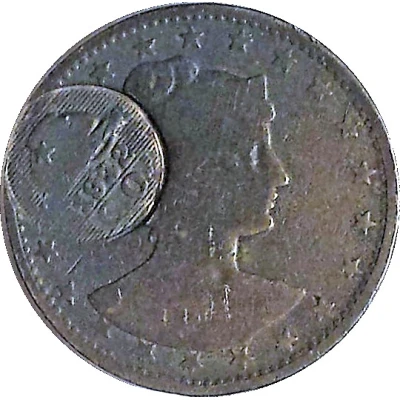
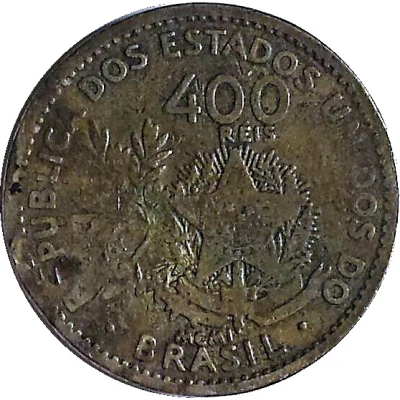

© Wilson Roberto Vasques Nunes
400 Réis with stamp of the "Campanha do Ouro"
1901 year| Copper-nickel | 12 g | 30 mm |
| Location | Brazil |
|---|---|
| Type | Medals › Advertising medallions |
| Year | 1901 |
| Value | 400 Réis |
| Composition | Copper-nickel |
| Weight | 12 g |
| Diameter | 30 mm |
| Thickness | 2 mm |
| Shape | Round |
| Orientation | Coin alignment ↑↓ |
| Demonetized | Yes |
| Updated | 2024-11-12 |
| Numista | N#128708 |
|---|---|
| Rarity index | 97% |
Reverse
Coat of Arms.
Script: Latin
Lettering:
REPUBLICA DOS ESTADOS UNIDOS DO
400
RÉIS
MCMI
• BRASIL •
Translation:
UNITED STATES REPUBLIC OF
400
RÉIS
MCMI
• BRAZIL •
Edge
Plain
Comment
Piece stamped on 400 Réis of 1901 (KM# 505).Historical Reference
São Paulo, July 9, 1932, a revolt against President Getúlio Vargas forced the sending of federal troops to contain the rebellion. The São Paulo forces fought against the army for three consecutive months, making the episode known as the Constitutionalist Revolution of 1932.
By 1930, a revolution had overthrown the government of the large landowners (1) of Minas Gerais and São Paulo. Getúlio Vargas had assumed the presidency of Brazil on a provisional basis, but with broad powers. From the National Congress to the Municipal Councils, all legislative institutions were abolished, and the state governors were deposed and replaced by interveners.
Vargas' centralizing policy displeased state oligarchies (2), especially those in Sao Paulo, the nation's most economically important state. In 1932, a strike mobilized 200,000 workers in the state causing entrepreneurs and landowners of São Paulo to unite against Vargas.
A major rally held on May 23, 1932, demanding a new constitution for Brazil, ended in armed conflict and four students died: Martins, Miragaia, Dráuzio and Camargo, giving rise to the great symbol of revolution: the acronym MMDC. These deaths were the fuse to start, on July 9, 1932, the greatest civil war in Brazilian history.
On July 14, the governor Pedro de Toledo decrees the creation of a war bonus that serves the functions of money. To shore up it was launched the campaign "Donate gold for the good of São Paulo", centralized by the trade association together with the banks.
In October 32, after three months of struggle, the Paulistas surrendered. Despite the defeat, the struggle was not in vain: two years after the revolution, a people-elected assembly promulgated the new Magna Carta.
Stamp of the Helmet - Gold Campaign
In the middle of 1935, in the final phase of the distribution of the collection of goods acquired and not used in the gold campaign, by the charge of the Holy House of Mercy of São Paulo, the idea was to mark the old coins for posterity.
The mark - a stamp with a helmet and the caption "1932 C.O." (1932, Gold Campaign) - became known as the "Stamp of the Helmet" or the "Stamp of the Golden Campaign" and, since its creation, generates a great controversy about how many were stamped and in what circumstances, some affirm that circulating coins have been stamped and many are false. In any case, they are very scarce coins today and with a huge historical significance.
The numismatist Kurt Prober recognizes stamps applied on copper (colonial or imperial), bronze (10, 20 or 40 reis, imperial or republican), nickel, silver (after 1849) and colonial silver from the first Kingdom.
